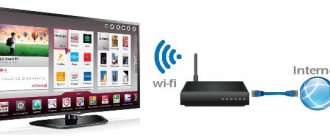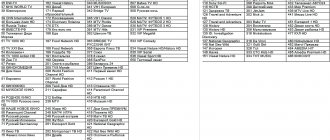Author of the article
Alexander Georgievich Kondratiev
An electrical engineer by training, he worked as an electronics engineer, chief engineer at a food company, and general director of a construction organization.
The average Russian spends several hours a day in front of a television screen. This means that it is connected to the electrical network all this time. It is interesting to know how much electricity a TV consumes. And how to choose the right TV receiver to reduce costs.
What does energy consumption depend on?
The main indicator of energy consumption is the power of the TV. It is indicated in the passport or operating instructions. Measured in watts. A television receiver is one of the devices that does not operate 24 hours a day.
Therefore, the following factors influence the energy consumption of modern TVs:
- Screen size and type of television receiver - what technology is used in its manufacture. The most energy-intensive devices are old ones, with cathode ray tubes, and the minimum consumption is on a TV with an LCD screen (with the same diagonal size);
- Receiver operating time. The longer it is turned on, the more electricity it will consume;
- Balance white, black, screen brightness;
- Sleep mode and enabled features. For example, a presence sensor.
The owner can assess the power of an electrical appliance from its screen. Since the main consumer of electricity is the screen, we can say that the larger it is, the more electricity the TV consumes.
What is energy efficiency class
The concept of energy efficiency was introduced quite recently. It is designated by letters of the Latin alphabet from A to G. Each letter has a color designation.
As indicated in the table below.
| Class | Energy efficiency indicator % | Color corresponding to class |
| A+++ | <10 | Dark green |
| A++ | <16 | Green |
| A+ | <23 | Light green |
| A | <30 | Yellow |
| IN | <42 | Light brown |
| WITH | <60 | Brown |
The remaining classes from D to G have red color stripes of varying intensities. The power consumption of televisions of these classes is high. The industry does not produce such television receivers. The class is indicated on the packaging in the form of a colored arrow with a letter designation.
Class A+++ - low power consumption, C - high.
The energy efficiency indicator is a calculated value. It is calculated using a complex formula that takes into account numerous factors. Shows the relationship between the calculated (laboratory) value and the actual power consumption of the TV. The value is obtained as a percentage.
Appearance of equipment markings
The sticker is made in the shape of a rectangle measuring 120x60 mm in light yellow color.
At the top:
- seven bands of increasing length and pointed on the right side, starting with class A (green) and ending with class G (red) with a change in color along the spectrum;
- the interval between stripes is 0.75 mm, the height of the strip is 3.8 mm;
- a black arrow indicating the class of the TV.
In the lower part:
- A square with an image of the power button (if there is a checkmark in it in the device itself, is a function of switching to standby mode when the power consumption is less than 10 Wh).
- A square indicating the power consumption of the TV.
- A larger square indicating the annual consumption of the device in kWh.
- Diagonal size in centimeters and inches.
Calculation for different types of TVs
The power consumption of a TV depends on its screen. The larger the screen, the higher the energy consumption of the receiver. In order to find out how many kilowatts a TV consumes, you need to know its power.
It is indicated in the receiver's passport. Frequently consumed electricity is indicated in the operating instructions in the “characteristics” section. You can look at the device nameplate. It is located on the back of the receiver.
Knowing the power consumption, we will calculate how much electricity is needed to watch TV shows. Let's look at different types of television receivers and make calculations.
Old models with CRT
The previous generation of television receivers was not very economical. They used incandescent lamps and cathode ray tubes.
The industry did not indulge the consumer with a wide variety of models and screen sizes. Black and white or color receivers were produced. Currently, such television receivers are not available in the retail chain.
Tube models consumed up to 650 W. The latest models were produced on microcircuits. Power has decreased significantly, for example, the most popular 20-inch TVs consumed 250 W per hour of operation. At the same time, the set of functions is significantly less than that of modern TV.
Let's make a calculation, taking into account that the owner spends five hours watching the TV screen. To do this, we multiply the power by the time of the TV broadcast.
250*5=1250. A television receiver with a CRT consumes 1250 W or 1.25 kW per day. At the same time, such TVs consume 0.9 W in sleep mode. The duration of sleep per day is 24-5 (watching time) = 19 hours.
Let's calculate the electricity consumption in sleep mode.
0.9/24=0.037 per hour. 19*0.037=0.7 W per day.
Let's find out how much the receiver consumes in total per day. 1250+ 0.7=1250.7 W.
Per month, this figure will be equal to 1250.7 * 30 = 37,521 W or 37.521 kW.
Multiply by the tariff, we get the cost of electricity.
Tariffs in each region are different. For example, let's take the tariff of Kursk. It is equal to 4.03 per 1 kW.
37.521*4.03=151 rub.
The owner of an old TV with a kinescope will pay 151 rubles for watching TV shows. per month.
Read how much electricity a refrigerator consumes.
LCD and LED
LCD TV sets use a liquid crystal screen. Formally, LED technology refers to LCD TVs. However, instead of an LCD screen, an LED matrix is used.
This advanced technology is used on the latest models. Features high-quality images. The technology allows you to create large screens without losing quality. The power consumption parameters of LCD and LED are comparable.
Depending on the screen size, they consume from 110 to 30 W. Average power consumption ranges from 60 to 70 W.
For example, let's take a 32-inch Samsung TV type UE32N5000AUXRU, 32'', FULL HD with a power consumption of 66 W. In sleep mode it consumes 0.07 W per day. Let's do the calculations.
66*5=330 W;
0.07/24=0.003 W of energy is consumed by the TV per hour in sleep mode or in 15 hours 15*0.003=0.045 W per day;
The total consumption is 330+0.045=330.045W.
The monthly will be 330.045*30= 9901.35 W or 9.9 kW.
Multiplying by the current tariff, we get 9.9 * 4.03 = 39.9 rubles. per month.
The owner will have to pay 39.9 rubles per month for watching TV programs.
Plasma panels
Plasma receivers are not as popular as LCD receivers. However, they are widely represented in the retail chain.
For example, let's take a modern plasma TV from Samsung PS-42P3SR 42'' with a 42-inch screen.
The specifications indicate that the TV consumes 330 watts per hour.
We will perform the calculation similarly to the previous ones. That is, the owner watches programs for 5 hours every day. In sleep mode, the TV consumes no more than 0.3 W per day.
Let's do the calculation.
330*5=1650 W.
In sleep mode 0.3/24=0.012 per hour or 0.012*19=0.23 W per day.
Which is a total of 1650+0.23=1650.23 W.
The monthly electricity consumption will be 1650.23*30=49,506.9 W or 49.5 kW.
Thus, multiplying by the tariff, we find out how much money the owner must pay for monthly viewing of TV shows. 49.5*4.03=199.5 rub. per month.
For clarity, let's summarize the data in a single table.
| TV receiver type, screen | Power consumption, W | Consumption in sleep mode, W | Total daily consumption, kW | Electricity consumption per month, kW | Monthly payment, rub. |
| CRT, 20 inches | 250 | 0,7 | 1,2507 | 37,521 | 151 |
| LED, 32 inches | 66 | 0,07 | 0,330 | 9,9 | 39,9 |
| Plasma, 42 inches | 330 | 0,3 | 1,65023 | 49,5 | 199,5 |
From the table above we can conclude that energy consumption depends on the size of the screen. However, the most economical receivers are TVs with LED screens. The combined table compares the characteristics of models often purchased by customers. This is a very rough estimate.
For objectivity, it should be taken into account that a plasma receiver has a screen twice as large as a CRT. And electricity consumption differs slightly.
Calculation of energy consumption of LCD TV per day, per month, per year
To calculate the average amount of energy that a TV consumes over a certain period of time, you can use the manufacturer’s data. Namely, the number indicated on the energy efficiency standard card. The power given by the manufacturer (consumed per month) is multiplied by a coefficient, which is defined as the ratio of the average operating time per day to four hours, as well as adjustments for the usual brightness level and the operation of the wireless adapter.
For example, the TV card indicates that it consumes 26 kW per month. However, it is installed in a bright room and set to 80% backlight. The user often uses the TV to access the Internet, and the device works on average 6 hours a day. The coefficient is determined as basic (6/4)*(80/50)*1.2 = 2.88
Calculating your monthly consumption is easy. It will be equal to 26*2.88=74.88 kW. The daily electricity consumption can be determined by division, and the annual average by multiplication. However, this figure is not considered completely reliable. For example, a user sometimes listens to his favorite TV shows on headphones or, conversely, enjoys music programs at full volume.
Advice! It is possible to determine the real indicator of how much electricity a TV consumes per hour only through practical measurements. This is done with a special device. Being an adapter between the TV power plug and the socket, it records operating currents and voltage, calculating the power consumed. They are sold both on the domestic market and on the Aliexpress global trading platform.
Ways to save energy
All TVs consume electricity. And electricity bills are constantly rising. Therefore, there is a reasonable desire to find ways to save it.
Reasonable use
When watching television, you need to think carefully about the operating time of the television receiver. To ensure that the electric meter does not waste extra kilowatts, you should follow simple rules:
- Install the TV receiver in a room with uniform lighting. This will allow you to adjust the brightness and contrast to a minimum;
- Adjust the brightness while watching depending on the light in the room. For example, at night you can make the tones and brightness muted. What will have a beneficial effect on vision;
- After the transmission is complete, unplug the power supply. Do not leave the TV in standby mode;
- To avoid spending extra money, it is recommended to reduce the screen backlight;
- Buy a receiver with the smallest possible diagonal. This will save wasted energy.
Eco modes
Modern devices allow you to independently adapt to your surroundings when watching programs. This allows you to reduce energy consumption in automatic mode.
To enable eco mode, you need to enter the “settings” menu and enable the function. It is able to adjust the power of the TV depending on the program being watched and external conditions.
It is enabled during initial settings. However, this mode is not available in all models.
Presence sensor
When buying a new television receiver, pay attention to the presence of a motion sensor in the model. It turns off the TV and puts it into standby mode with minimal power consumption if the owner has left the room. When a person returns to the room, the sensor detects the movement and turns on the TV automatically. Thus, this feature will reduce energy costs.
If the owner watches a program and often leaves the room, the function will save up to 5-10% of consumed electricity.
Useful article? Rate and share with friends!
Determination of power consumption
For information about turning on your TV, see the included documentation. You can contact him. However, practice shows that this figure differs from the actual figure obtained from experience. The actual electricity consumption of a TV, like other household appliances, can be determined in several ways.
Visual representation of TV energy consumption
Apartment meter
An inexpensive method that does not require knowledge of electrical properties is to read from an electric meter:
- Unplug all devices, including those in standby or sleep mode;
- record the electric meter readings, time them and turn on the TV;
- Exactly one hour later, turn off the device, write down the meter readings;
- The previous readings are subtracted from the last to obtain the number of kilowatts consumed per hour.
By multiplying the resulting energy consumption by the electricity tariff in the region of residence, the amount of operating costs in rubles is obtained.
How much electricity is used by household appliances
Sources
- https://tv-vybor.ru/stati/803-skolko-jenergii-potrebljaet-televizor.html
- https://oschetchike.ru/kak-ekonomit/skolko-potreblyaet-televizor
- https://PoUchetu.ru/interesnoe/potreblenie-televizora
- https://televizore.ru/sovety/moshhnost-televizora
- https://ProNormy.ru/tekhnika/bytovaya/skolko-potreblyaet-televizor-elektroenergii-v-chas











